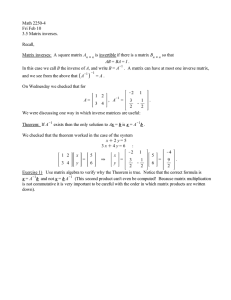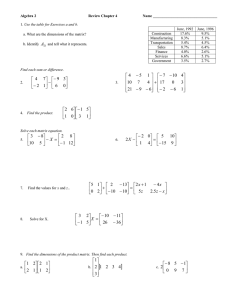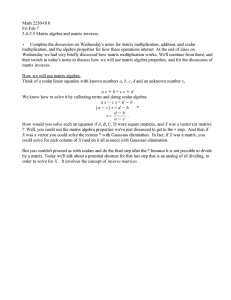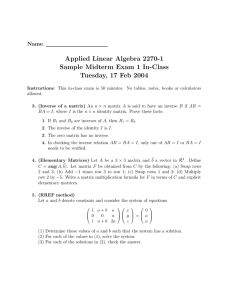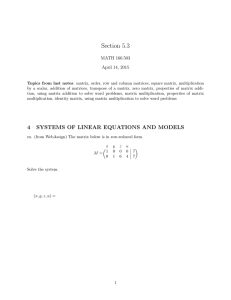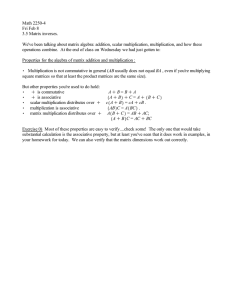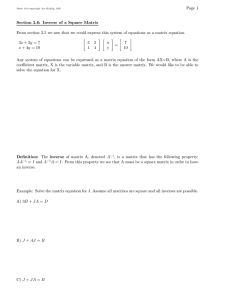Math 2250-1 Fri Sept 21 3.5 Matrix inverses.
advertisement
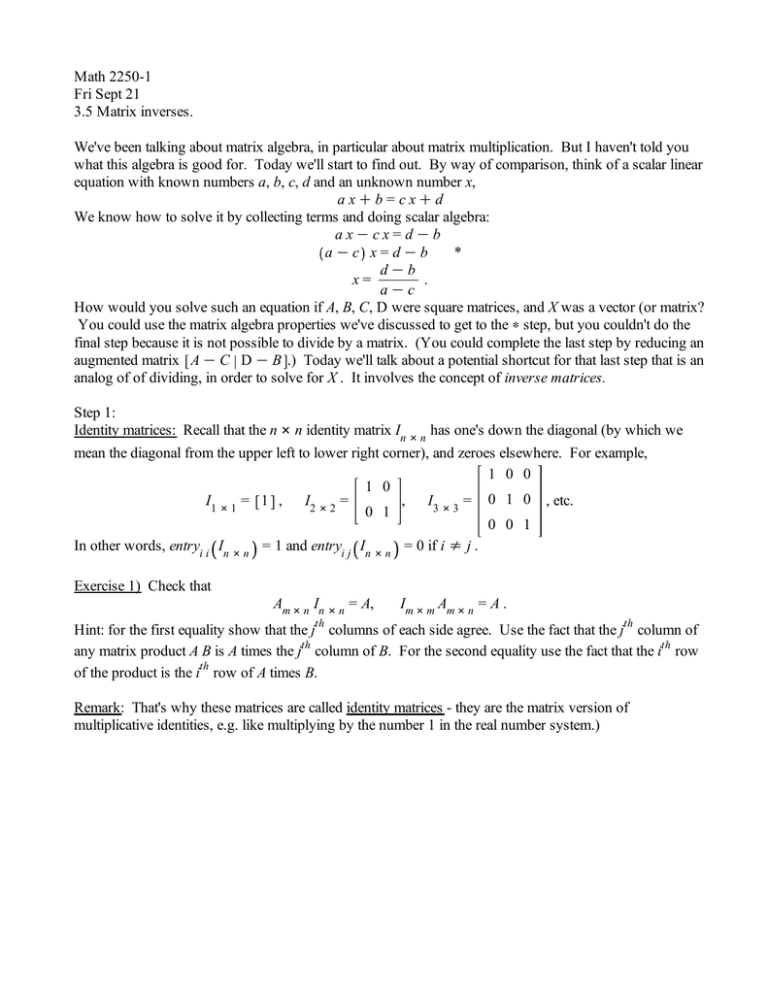
Math 2250-1 Fri Sept 21 3.5 Matrix inverses. We've been talking about matrix algebra, in particular about matrix multiplication. But I haven't told you what this algebra is good for. Today we'll start to find out. By way of comparison, think of a scalar linear equation with known numbers a, b, c, d and an unknown number x, a xCb = c xCd We know how to solve it by collecting terms and doing scalar algebra: a xKc x = dKb aKc x = dKb * dKb x= . aKc How would you solve such an equation if A, B, C, D were square matrices, and X was a vector (or matrix? You could use the matrix algebra properties we've discussed to get to the ∗ step, but you couldn't do the final step because it is not possible to divide by a matrix. (You could complete the last step by reducing an augmented matrix A K C D K B .) Today we'll talk about a potential shortcut for that last step that is an analog of of dividing, in order to solve for X . It involves the concept of inverse matrices. Step 1: Identity matrices: Recall that the n # n identity matrix In # n has one's down the diagonal (by which we mean the diagonal from the upper left to lower right corner), and zeroes elsewhere. For example, 1 0 0 1 0 I1 # 1 = 1 , I2 # 2 = , I3 # 3 = 0 1 0 , etc. 0 1 0 0 1 In other words, entryi i In # n = 1 and entryi j In # n = 0 if i s j . Exercise 1) Check that Am # n In # n = A, Im # m Am # n = A . Hint: for the first equality show that the jth columns of each side agree. Use the fact that the jth column of any matrix product A B is A times the jth column of B. For the second equality use the fact that the ith row of the product is the ith row of A times B. Remark: That's why these matrices are called identity matrices - they are the matrix version of multiplicative identities, e.g. like multiplying by the number 1 in the real number system.) Step 2: Matrix inverses: A square matrix An # n is invertible if there is a matrix Bn # n so that AB = BA = I . In this case we call B the inverse of A, and write B = AK1 . Remark: A matrix A can have at most one inverse, because if we have two candidates B, C with AB = BA = I and also AC = CA = I then BA C = IC = C B AC = BI = B so since the associative property BA C = B AC is true, it must be that B = C. K2 1 1 2 Exercise 2a) Verify that for A = the inverse matrix is B = 3 1 . 3 4 K 2 2 Inverse matrices are very useful in solving algebra problems. For example Theorem: If AK1 exists then the only solution to Ax = b is x = AK1 b . Exercise 2b) Use the theorem and AK1 in 2a, to write down the solution to the system xC2 y = 5 3 xC4 y = 6 Exercise 3a) Use matrix algebra to verify why the Theorem is true. Notice that the correct formula is x = AK1 b and not x = b AK1 (this second product can't even be computed because the dimensions don't match up!). 3b) Assuming A is a square matrix with an inverse AK1 , and that the matrices in the equation below have dimensions which make for meaningful equation, solve for X in terms of the other matrices: XA C C = B Step 3: But where did that formula for AK1 come from? Answer: Consider AK1 as an unknown matrix, AK1 = X . We want AX=I. In the 2 # 2 case, we can break this matrix equation down by columns: A col1 X col2 X = 1 0 . 0 1 We've solved several linear systems for different right hand sides but the same coefficient matrix before, so 1 let's do it again: the first column of X = AK1 should solve A x = and the second column should solve 0 Ax= 0 1 . Exercise 4: Reduce the double augmented matrix 1 2 1 0 3 4 0 1 K1 to find the two columns of A for the previous example. Exercise 5: Will this always work? Can you find AK1 for 1 5 1 A := 2 5 0 2 7 1 ? 1 5 5 Exercise 6) Will this always work? Try to find BK1 for B := 2 5 0 . 2 7 4 Hint: We'll discover that it's impossible for B to have an inverse. Exercise 7) What happens when we ask software like Maple for the inverse matrices above? > with LinearAlgebra : 1 5 1 > K1 2 5 0 ; 2 7 1 1 5 5 > 2 5 0 2 7 4 K1 ; Theorem: Let An # n be a square matrix. Then A has an inverse matrix if and only if its reduced row echelon form is the identity. In this case the algorithm illustrated on the previous page will always yield the inverse matrix. explanation: By the previous theorem, when AK1 exists, the solutions to linear systems Ax=b K1 are unique (x = A b . From our discussions on Tuesday and Wednesday, we know that for square matrices, solutions to such linear systems exist and are unique only if the reduced row echelon form of A is the identity. (Do you remember why?) Thus by logic, whenever AK1 exists, A reduces to the identity. In this case that A does reduce to I, we search for AK1 as the solution matrix X to the matrix equation AX=I i.e. 1 0 0 A col1 X col2 X .... coln X = 0 1 0 0 0 .... 0 0 0 1 Because A reduces to the identity matrix, we may solve for X column by column as in the examples we just worked, by using a chain of elementary row operations: A I ///// I B , and deduce that the columns of X are exactly the columns of B, i.e. X = B. Thus we know that AB=I. To realize that B A = I as well, we would try to solve B Y = I for Y, and hope Y = A . But we can actually verify this fact by reordering the columns of I B to read B I and then reversing each of the elementary row operations in the first computation, i.e. create the chain B I ///// I A . so B A = I also holds. (This is one of those rare times when matrix multiplication actually is commuative.) To summarize: If AK1 exists, then the reduced row echelon form of A is the identity. If the reduced row echelon form of A is the identity, then AK1 exists. That's exactly what the Theorem claims. There's a nice formula for the inverses of 2 # 2 matrices, and it turns out this formula will lead to the next text section 3.6 on determinants: Theorem: a b c d K1 exists if and only if the determinant D = ad K bd of a b c d is non-zero. And in this case, a b K1 d Kb 1 ad K bc Kc a c d (Notice that the diagonal entries have been swapped, and minus signs have been placed in front of the offdiagonal terms. This formula should be memorized.) = Exercise 8a) Check that this formula for the inverse works, for D s 0 . (We could have derived it with elementary row operations, but it's easy to check since we've been handed the formula.) 8b) Even with systems of two equations in two unknowns, unless they come from very special problems the algebra is likely to be messier than you might expect (without the formula above). Use the magic formula to solve the system 3 xC7 y = 5 5 xC4 y = 8 . Remark: For a 2 # 2 matrix a b , the reduced row echelon form will be the identity if and only if the c d two rows are not multiples of each other. If a, b are both non-zero this is equivalent to saying that the c d ratio of the first entries in the rows s , the ratio of the second entries. Cross multiplying we see a b this is the same as ad s bc , i.e. ad K bc s 0 . This is also the correct condition for the rows not being multiples, even if one or both of a, b are zero, and so by the previous theorem this is the correct condition for knowing the inverse matrix exists. Remark: Determinants are defined for square matrices An # n and they determine whether or not the inverse matrices exist, (i.e. whether the reduced row echelon form of A is the identity matrix).And in these cases there are analogous (more complicated) magic formulas for the inverse matrices. This is section 3.6 material that we'll discuss carefully on Monday and Tuesday.


